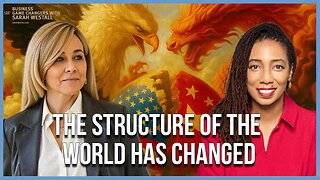Premium Only Content

Episode 3147: The Mass of the Ages: Step-by-Step Commentary on the Traditional Mass - Part 2 - Mass of the Catechumens
Nightly Zoom Coordinates for Rosary:
Meeting ID: 865 8978 0399
Passcode: Wjjv4960!
Speak Lord for your Servant is Listening
Book Recommendation of the Day
"The Brown Scapular and St. Simon Stock"
Author: Fr. Paul O’Sullivan, O.P.
Summary: Explores the history and powerful promises associated with the Brown Scapular, including the apparition to St. Simon Stock. A short but very compelling account for those wishing to understand the significance of Our Lady of Mount Carmel and her scapular.
The Mass of the Ages: A Step-by-Step Commentary on the Traditional Latin Mass (Part II)
Welcome, dear listeners, to another episode of The Mass of the Ages, where we explore the timeless beauty, mystery, and theology of the Traditional Latin Mass, also known as the Tridentine Mass the form of the Roman Rite codified at the Council of Trent and preserved in the 1962 Roman Missal.
Today’s episode is Part II of our step-by-step commentary. In Part I, we examined the Prayers at the Foot of the Altar, the Kyrie, the Gloria, and the Introit the sacred opening steps of the Mass of the Catechumens.
Today, we continue our spiritual journey as we move deeper into the Liturgy of the Word and then transition to the Liturgy of the Faithful, with the beginning of the Holy Sacrifice.
Segment 1: The Collect: The Gathering Prayer
After the Gloria or immediately after the Kyrie on days when the Gloria is omitted the priest kisses the altar as a sign of reverence for Christ, who is the altar and the sacrifice.
He then turns to the faithful and says, “Dominus vobiscum” “The Lord be with you.” It’s a powerful moment the priest, acting in persona Christi, greets the people in the name of the Lord.
Then he returns to the missal and recites the Collect a short prayer that “collects” the intentions of the Church and offers them to God in a succinct, doctrinally rich petition. Each Collect is unique to the day and reflects the theme of the feast or liturgical season.
These ancient prayers, many written over a millennium ago, are deeply theological, often structured in three parts: a direct address to God, a statement of His attributes or past actions, and a specific petition.
For example, on the Fifth Sunday after Pentecost, the Collect reads:
“O God, Who hast prepared for them that love Thee such good things as pass understanding: pour into our hearts such love toward Thee, that loving Thee above all things, we may obtain Thy promises, which exceed all that we can desire.”
We hear the echo of the Apostle Paul’s words: “Eye hath not seen, nor ear heard…what God hath prepared for them that love Him.” (1 Cor 2:9)
Segment 2: The Epistle – The Voice of the Apostles
Next, the priest reads the Epistle, usually from the writings of St. Paul, though occasionally from other Apostolic letters. He reads it from the right side of the altar the “Epistle side” symbolizing the instruction of the Old Law and the moral teaching of the New.
The Epistle is read facing the altar, not the people a reminder that this is addressed first to God, and only then to the faithful. The Mass is not a dialogue between priest and people. It is a sacrifice to the Eternal Father.
These letters are filled with exhortations to holiness, patience in suffering, endurance in persecution, and faith in Christ. In the Traditional Rite, there is no commentary, no interpretation just the pure, inspired words of Scripture.
Consider the Epistle for the Fifth Sunday after Pentecost, from 1 Peter 3:8–15:
“Be ye all of one mind, having compassion one of another…Not rendering evil for evil…But sanctify the Lord Christ in your hearts.”
These words are not mere advice they are a call to supernatural virtue.
Segment 3: The Gradual and Alleluia – A Bridge of Praise
Following the Epistle, the Gradual is sung a meditative, poetic passage from the Psalms, often chanted by a schola. It is contemplative, slow, and reverent unlike the rapid recitation often found in modern liturgies.
The Alleluia follows, except during penitential seasons, when it is replaced by the Tract. The Alleluia is not just a cry of joy it’s a mystical ascent of the soul, preparing us for the hearing of the Holy Gospel.
These chants link the Old and New Testaments, forming a bridge from the Law and Prophets to the voice of Christ Himself.
Segment 4: The Holy Gospel – Christ Speaks
Now, the priest moves to the left side of the altar the Gospel side. This movement is not arbitrary it signifies the transition from Judea (right side) to the Gentile world (left side), as the Gospel now goes forth to all nations.
The priest bows deeply before the altar, praying:
“Cleanse my heart and my lips, O Almighty God, who didst cleanse the lips of the prophet Isaiah with a burning coal: vouchsafe so to cleanse me that I may worthily proclaim Thy holy Gospel.”
He then reads the Gospel, which contains the very words of Christ or events from His life and ministry. This is the high point of the Liturgy of the Word. The faithful stand, showing reverence for the King of Kings.
We sign our forehead, lips, and heart symbolizing our desire to understand, proclaim, and love the Gospel.
For example, on the Fifth Sunday after Pentecost, the Gospel is taken from St. Matthew 5:20–24:
“Unless your justice exceeds that of the scribes and Pharisees, you shall not enter into the kingdom of heaven…”
This is not merely a historical teaching this is Christ speaking directly to us, warning us that outward observance alone is not enough.
Segment 5: The Homily – Instruction for the Faithful
At this point, the priest may give a homily though in the Traditional Rite, it is optional, and not integrated into the liturgy itself. Traditionally, this is where the priest teaches the faithful, explaining the readings and offering moral or doctrinal guidance.
In a reverent TLM parish, the homily will be free of novelty, modernism, or personal opinion and instead focus on Catholic doctrine, the lives of the saints, or the mysteries of the Faith.
Segment 6: The Credo – The Creed of the Church
On Sundays and certain feast days, the priest begins the Credo, or Nicene Creed, at the center of the altar. This Creed was composed to defend the Faith against heresies notably Arianism, which denied the divinity of Christ.
As the priest says, “Credo in unum Deum…” — “I believe in one God…” the faithful kneel at the words “Et incarnatus est de Spiritu Sancto ex Maria Virgine, et homo factus est” — “And was incarnate by the Holy Ghost of the Virgin Mary, and was made man.”
This moment recalls the Incarnation, when the Eternal Word took flesh in the womb of the Blessed Virgin. It’s not just a profession of faith it’s a profound act of adoration of the Mystery of the Word made flesh.
The Creed is a solemn, public declaration of the truths we are bound to believe unchanging, eternal, and preserved through the centuries.
Segment 7: The Offertory – The Beginning of Sacrifice
Now begins the Offertory, the transition from the Mass of the Catechumens to the Mass of the Faithful. The priest unveils the chalice and offers the bread and wine separately.
These offerings are not symbolic they are real gifts offered to God to become the very Body and Blood of Christ.
The Offertory prayers are ancient, deeply sacrificial, and omitted in the Novus Ordo. The priest prays:
“Accept, O Holy Father, almighty and eternal God, this unspotted host, which I, Thine unworthy servant, offer unto Thee…”
Then he offers the chalice:
“We offer unto Thee, O Lord, the chalice of salvation, beseeching Thy clemency, that it may ascend before Thy divine Majesty…”
The priest then bows deeply and prays for a contrite heart, saying:
“With a spirit of humility and a contrite heart, may we be received by Thee, O Lord…”
These prayers emphasize the sacrificial nature of the Mass an offering made by the priest, on behalf of the people, to God alone.
Segment 8: The Lavabo – Purity of the Priest
The priest washes his fingers at the Lavabo, praying Psalm 25:
“I will wash my hands among the innocent, O Lord, and will compass Thine altar…”
This symbolic washing reflects the priest’s need to be purified interiorly, preparing to handle the sacred mysteries.
It recalls both the Levitical purity of the Old Testament priests and Pontius Pilate’s washing of hands, but here with the intention of humility and innocence before God.
Segment 9: Orate Fratres and the Secret
Finally, the priest turns and says:
“Orate, fratres, ut meum ac vestrum sacrificium acceptabile fiat apud Deum Patrem omnipotentem.”
“Pray, brethren, that my sacrifice and yours may be acceptable to God the Father Almighty.”
The server on behalf of the people responds:
“May the Lord receive the sacrifice at thy hands, to the praise and glory of His name…”
Then the priest returns to the altar and, in silence, recites the Secret a hidden prayer asking God to accept the offerings. These silent prayers reflect the mystery and heavenly intimacy of what is about to take place.
The curtain of Heaven is about to be drawn back...
And so, dear listeners, we end Part II of our step-by-step commentary. We've journeyed through the heart of the Mass of the Catechumens and entered into the preparation for the Sacrifice.
In our next episode, Part III, we will begin the Preface, the Sanctus, and the Roman Canon the very heart of the Holy Sacrifice of the Mass.
Thank you for joining me on The Mass of the Ages. Don’t forget to subscribe and tune in to Part III, where we will enter the Holy of Holies the Canon of the Mass.
Until then, may God bless you, and may Our Lady keep you always under her maternal mantle.
This day calls us to meditate deeply on the twin themes of interior holiness and divine mercy, particularly through Our Lady’s role as our heavenly advocate and the readings from Holy Scripture.
Epistle – 1 Kings 18:42-45 (Commemoration of Our Lady of Mount Carmel)
"Elias went up to the top of Carmel, and casting himself down upon the earth, put his face between his knees... and behold a little cloud arose out of the sea like a man's foot... and the heaven grew dark with clouds and wind, and there fell a great rain."
Reflection:
The Prophet Elias on Mount Carmel is a type a prefiguration of Our Lady. Just as the small cloud brought abundant rain to end Israel’s drought, so too did Our Lady’s “yes” bring forth the Savior, ending the spiritual drought of sin. The cloud rising from the sea symbolizes the Immaculate Conception Our Lady arising, pure and untouched, from the fallen sea of humanity.
Mount Carmel is thus not just a place it is a symbol of elevation, prayer, and divine encounter. The Carmelite tradition has long taught us that devotion to Our Lady is the surest, safest, and swiftest path to union with Christ.
Gospel – Matthew 5:1-12 (Beatitudes)
"Blessed are the poor in spirit... Blessed are the pure of heart, for they shall see God..."
Reflection:
Today’s Gospel gives us the Beatitudes, the charter of Christian holiness. These words of Our Lord are not mere poetry they are divine instructions for sainthood. The world calls blessed those who are rich, powerful, and proud. But Christ tells us that true blessedness lies in humility, mourning for sin, meekness, mercy, and the thirst for righteousness.
Our Lady of Mount Carmel embodied the Beatitudes perfectly. She was poor in spirit, submissive to God’s will. She was pure of heart, conceived without sin. She mourned at the foot of the Cross. She was the Queen of Martyrs, even though she suffered without shedding blood.
On her feast, we are reminded that the path to holiness is not through revolution or innovation, but through quiet conformity to Christ. Our Lady's brown scapular is a mantle of humility and protection. It reminds us: “Whosoever dies clothed in this scapular shall not suffer eternal fire.” This is no superstition it is a promise rooted in Marian devotion and faithful living.
Saint of the Day – Our Lady of Mount Carmel
This feast, dating back to at least the 14th century, honors the Blessed Virgin Mary under the title of Mount Carmel. The Carmelite Order, with origins traced to the Prophet Elias, has always seen Mary as their protectress and Queen of the Order. She gave the brown scapular to St. Simon Stock in 1251 as a sign of salvation and spiritual armor.
Devotion to Our Lady under this title reminds us that the Blessed Virgin is the surest guide to Christ, the Mediatrix of all graces, and the Refuge of sinners. She covers us in her mantle just as she did the Apostles in the Cenacle.
Quotes & Themes for Meditation:
• “He who is humble and patient will be at peace in all things.” – Imitation of Christ
• “To Jesus through Mary.” – St. Louis de Montfort
• “Blessed are the clean of heart: for they shall see God.” – Matt. 5:8
• Theme 1: The path to holiness is hidden in humility and purity.
• Theme 2: Devotion to Our Lady is not optional—it is vital.
• Theme 3: The scapular is a sign of consecration, a call to daily conversion and Marian protection.
Conclusionary Prayer:
Let us pray.
O Most Blessed Virgin Mary of Mount Carmel, Queen and Beauty of Carmel, look down graciously upon us who seek thy help. Cover us with thy scapular, the sign of thy maternal love, and lead us ever closer to thy Son, Our Lord Jesus Christ.
O Mary, assumed into heaven, we entrust ourselves to thee. May we follow thy example of purity, humility, and perfect love. Grant, through thy intercession, that we may one day rejoice with thee in the eternal beatitude promised to the poor in spirit.
O Virgin of Carmel, pray for us sinners, now and at the hour of our death. Amen.
In the name of the Father, and of the Son, and of the Holy Ghost. Amen.
Closing Words:
Thank you for joining today’s episode of “Tradition & Truth.” May Our Lady of Mount Carmel enfold you in her mantle and guide you in all your trials. Remember, the road to Heaven is narrow, but it is lit by the torch of truth and safeguarded by our Mother.
Until next time—keep the faith, live the truth, and hold fast to tradition.
Our Lady of Mount Carmel—pray for us.”
-
 LIVE
LIVE
FreshandFit
7 hours agoGianni Blu Meets 305
3,161 watching -
 LIVE
LIVE
Badlands Media
8 hours agoDEFCON ZERQ Ep. 014
10,530 watching -
 LIVE
LIVE
Inverted World Live
4 hours agoTop General Outsourcing Decisions to ChatGPT | Ep. 127
2,751 watching -
 LIVE
LIVE
Laura Loomer
3 hours agoEP151: Democrats Meet With Terror Tied Islamic Group During Government Shutdown
573 watching -
 LIVE
LIVE
TimcastIRL
3 hours agoPortland Police PROTECT Antifa From DHS Arrest, Trump Admin Says SEND IN THE GUARD | Timcast IRL
6,934 watching -
 LIVE
LIVE
Barry Cunningham
2 hours agoPRESIDENT TRUMP SPEAKS TO THE PRESS...NO DEALS! DO YOU CARE IF THE GOVERNMENT STAYS SHUT DOWN?
1,559 watching -
 LIVE
LIVE
Tundra Tactical
58 minutes ago🚨🚨Emergency Gun News!!!!🚨🚨 Did Glock Just Cave To Liberal Pressure?? Current Glocks Done?
130 watching -
 1:02:57
1:02:57
Sarah Westall
4 hours agoStructure of the World has Changed and Getting Back to Basics w/ Stacy Washington
15.5K3 -
 6:34
6:34
Buddy Brown
6 hours ago $1.27 earnedWatch What Happens When WELFARE QUEENS Get Denied FOOD STAMPS! | Buddy Brown
3.61K9 -
 LIVE
LIVE
Drew Hernandez
13 hours agoCHARLIE KIRK TRIAL JUDGE ISSUES GAG ORDER & U.S. MARSHAL ILLEGAL ALIEN SHOOTOUT?
938 watching